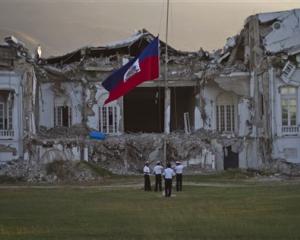The world has moved on from Haiti, hit six months ago by a devastating earthquake. But that does not mean the challenges the country faces have been solved. Far from it, says Dennis McKinlay.
It is now six months since a devastating 7.0 earthquake struck Haiti, killing more than 220,000 people, injuring more than 300,000, and displacing several million from their homes.
This was a modern-day disaster that gripped the attention of the entire world.
The earthquake was the most powerful to hit Haiti for 200 years, creating its worst-ever humanitarian crisis.
Haitian President Rene Preval described the earthquake as being like several Hiroshima bombs hitting the country.
The total value of damage and losses is estimated at $10.7 billion - equivalent to more than 120% of Haiti's 2009 gross domestic product.
The quake destroyed or damaged up to 300,000 houses.
As many as 2.3 million people were suddenly displaced from their homes, with little option but to live on the streets.
Others remained trapped in the rubble.
With almost half the population aged under 18, it was an unprecedented children's emergency.
The disaster struck at the very heart of Haiti's capital, paralysing most of the administrative system.
Almost all government ministries and key official buildings were destroyed and 25% of civil servants were killed.
And just when hospitals were needed most, more than 50 hospitals and health centres collapsed or became unusable, leaving those that remained overwhelmed by desperate patients.
Schools were hard-hit, with nine out of 10 schools in the earthquake zone destroyed or damaged and more than 1500 education staff killed.
These almost-5000 schools represent close to a quarter of all Haitian schools.
The international community responded with a huge global emergency relief effort, one of the largest humanitarian responses of its type.
Along with UN agencies like Unicef, governments and hundreds of non-government organisations leapt into action.
Unicef played a leading co-ordination role in emergency areas like nutrition, education, child protection, and water, sanitation and health.
The sheer enormity of the disaster, along with damage to critical infrastructure initially hampered aid efforts.
The main port was severely damaged, meaning the bulk of aid had to be flown in.
The airport simply couldn't cope with the huge demands placed on it by waves of aid flights and a lack of specialist unloading equipment and storage space.
Blocked roads hampered efforts to bring supplies in from the neighbouring Dominican Republic, as well as distributing them to survivors.
Since those first days of chaos, significant progress has been made on the ground.
Some four million people have received food assistance; emergency shelter materials have been distributed to one and a-half million; and one million people have benefited from cash-for-work programmes.
Unicef and its partners are providing safe water to 1.2 million people daily, ensuring each child gets at least five litres of water each day.
The goal is to increase this to at least seven and a-half litres per person by the end of the year.
Eleven thousand latrines have been installed, but with only one latrine for every 145 people in some areas, an additional 5500 toilets are planned.
Almost 90,000 hygiene kits have been distributed, along with support for school-based hygiene facilities, helping 20,000 children.
Nutrition programmes are providing food to 550,000 lactating women and children under 5, while more than 275,000 children have been immunised against major vaccine-preventable diseases.
Half a million children have been provided with basic education materials, while more than 1300 school tents have been distributed, with a further 2000 in the pipeline.
Special training has been targeted to 5300 teachers and education personnel.
In the longer term, Unicef is supporting a team of construction engineers to work with government counterparts on earthquake-resistant, semi-permanent and permanent school construction.
THIS is all real and measurable progress that is making a positive difference in survivors' lives, yet it only tells part of the picture.
There were initial fears about mass starvation and the possibility of disease breaking out in overcrowded camps.
That both these disasters failed to occur is a testimony to the effectiveness of the aid effort.
Reconstruction efforts are complicated by the need to address pre-existing problems.
At the time of the quake, Haiti was considered the poorest country in the Americas, with more than half the population living on less than $1.80 per day.
It was beset by a host of poor development indicators: nearly 60% of the population lacked access to clean water and almost three-fifths of children were undernourished.
In terms of education, less than half of school-aged children attended school, while almost two-fifths of the population over the age of 15 were illiterate.
Another significant challenge is that 1.6 million people - half of them children - continue to live in overcrowded, temporary settlements.
Apart from the ongoing need for emergency support and issues around safety, security and health, there is a real risk displaced persons' settlements may become urban slums.
Then there is the estimated 20 million cubic metres of rubble created by the earthquake.
Much of it continues to block streets and slow down the reconstruction effort.
One estimate puts the cost of clearing just 10% of the rubble at $170 million.
Fortunately the political situation remains relatively calm, with elections set for November 28.
A lot of help will be needed to make the elections a reality.
Apart from destroying all the key government buildings, the quake also destroyed Haiti's electoral council HQ.
Not only were tens of thousands of voters killed, but electoral records were devastated.
The UN has pledged to support the elections with security, logistical and technical assistance, and has already registered half a million people whose identity cards were lost in the chaos.
Emergency operations will likely continue in Haiti for the next 18 months, with the country gradually rebuilding.
The international community has pledged $13.8 billion in aid for the next three years and beyond.
Our hope is that all of this support becomes a reality and that life for Haiti's people, particularly the children, will be better than before the disaster.
This is as true in terms of basic indicators like access to clean water and nutrition status, as with child protection and access to education.
All children must have the opportunity to live lives free of preventable diseases.
They deserve the right to be protected from abuse and exploitation.
Not least, all of Haiti's children need the opportunity to attend school and contribute to a brighter future for their country.
Returning Haiti to its pre-earthquake state is simply not enough.
Dennis McKinlay is executive director of Unicef NZ.
Unicef NZ is running an appeal for Haiti, for more information, visit www.unicef.org.nz






